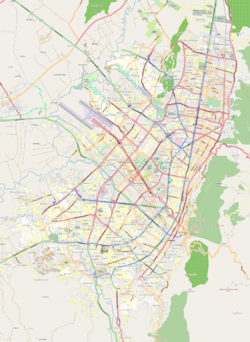Monserrate: Difference between revisions
No edit summary |
|||
| Line 23: | Line 23: | ||
[[Image:Bogota_location_map.png|thumb|250px]] |
[[Image:Bogota_location_map.png|thumb|250px]] |
||
== History == |
== History == |
||
The Governor of the Nuevo Reino de Granada (New Kingdom of Granada, what the majority of Colombia was called in the 17th century), Mr Juan de Borga authorized the building of a church in the name of Monserrat's Morena Virgin whose sanctuary was located in [[Barcelona]], [[Spain]]. |
The Governor of the Nuevo Reino de Granada ([[New Kingdom of Granada]], what the majority of Colombia was called in the 17th century), Mr Juan de Borga authorized the building of a church in the name of Monserrat's Morena Virgin whose sanctuary was located in [[Barcelona]], [[Spain]]. |
||
Don Pedro Solis created this piece of artwork taking advantage of the tranquility and harmony with nature.It was finally finished in 1657 with some help from the locals and to be later the home of a special shrine.Ever since then for more than four centuries pilgrims and citizen have hiked the mountain to offer their prayers to the shrine of "El Señor Caido". |
Don Pedro Solis created this piece of artwork taking advantage of the tranquility and harmony with nature.It was finally finished in 1657 with some help from the locals and to be later the home of a special shrine.Ever since then for more than four centuries pilgrims and citizen have hiked the mountain to offer their prayers to the shrine of "El Señor Caido". |
||
Revision as of 06:34, 16 November 2011
| Monserrate Mountain | |
|---|---|
 | |
| Highest point | |
| Elevation | 3,152 m (10,341 ft) |
| Geography | |
| Location | Bogotá, Colombia |
| Parent range | Andean Range |
Monserrate (after Catalan homonym mountain Montserrat) is a mountain that dominates the city center of Bogotá, the capital city of Colombia. It rises to 3,152 metres (10,341 ft) above the sea level, where there is a church (built in the 17th century) with a shrine, devoted to "El Señor Caído" (Fallen Lord).
The hill is a pilgrim destination, as well as a tourist attraction. In addition to the church, the summit contains restaurants, cafeteria, souvenir shops and many smaller tourist facilities. Monserrate can be accessed by aerial tramway, a funicular or by climbing, the preferred way of pilgrims.
All downtown Bogotá, south Bogotá and some sections of the north of the city are visible facing west, making it a popular destination for watching the sun set over the city.

History
The Governor of the Nuevo Reino de Granada (New Kingdom of Granada, what the majority of Colombia was called in the 17th century), Mr Juan de Borga authorized the building of a church in the name of Monserrat's Morena Virgin whose sanctuary was located in Barcelona, Spain.
Don Pedro Solis created this piece of artwork taking advantage of the tranquility and harmony with nature.It was finally finished in 1657 with some help from the locals and to be later the home of a special shrine.Ever since then for more than four centuries pilgrims and citizen have hiked the mountain to offer their prayers to the shrine of "El Señor Caido".

Both Monserrate and its neighbor Guadalupe Hill are icons of Bogota's cityscape.

Monserrate is also a place near Viana do Castelo, a town in the northern west of Portugal.
Land Railway
Monday-Saturday: 7:45 am to 11:45 am Sundays: 5:30 am to 6:30 pm Holidays: 6:00 am to 6:30 pm
Cable Railway
Monday-Saturday: 12 m to 12:00 pm Sundays: 9:00 am to 5:00 pm
See also
External links
- Cerro Monserrate
- Santuario Monserrate
- Template:En icon Places To Go in Bogotá: Monserrate Mountain top information
